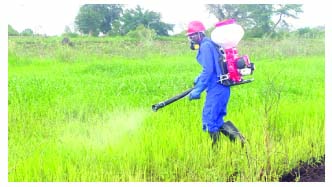By PRISCA KABWE
A THRIVING crop always gives hope to a farmer.
But in January of 2021, farmers of Sikauzwe camp in Kazungula district in Southern Province experienced some challenges in their crop cultivation due to the invasion of African Migratory Locusts (AML) in the area.
Rodgers Nyambe, 52, of Sianzila Village in Sikauzwe, is one of the farmers who got scared when he saw hopper bands.
Mr Nyambe even lost hope of having food to feed his wife and six children in the 2020-2021 farming season.
It was on a certain day one morning in January, 2021, when Mr Nyambe woke up to a rude shock.
He found hoppers eating the grass very close to his crops.
Only a space of one metre separated the hopper bands from his field of maize and sorghum which had just germinated.
Unlike the bad season of 2019-2020 when Sikaunzwe experienced consistent dry spells leading to poor yields, the 2020-2021 farming season looked promising because of the good rainfall.
But the presence of the locusts was about to shutter all hopethat the farmers like Mr Nyambe had.
Even though he alerted the agricultural extension officer of the presence of the locusts, Mr Nyambe remained in panic mode because the only road to his village was flooded, muddy and impassable due to heavy rains.
He wondered whether he would receive help.
“If it took a delay of even four days without any control, I could have lost all my crop. I did not even have money to buy seed for replanting,” Mr Nyambe said.
This invasion of the AML in Sianzila Village did not only pose a threat to Mr Nyambe but to 1,121 households in Sikaunzwe camp and more than 15,000 households in other areas.
If the hopper bands were not controlled at that stage, they could have become adults and started laying eggs, form a swarm and fly to other areas.
According to the Ministry of Agriculture officials in the district, the locust invasion threatened 1,200hectares of crops in Sikaunzwe agricultural camp and more than 40,000 hectares in other agricultural camps.
Nevertheless, a dedicated team of agricultural extension officers, together with community volunteers, responded promptly by finding means of accessing Mr Nyambe’s farm.
The only mode of transport that could be usedwas traditionalcanoeswhich could cross over to his village.
Ground spraying of chemicals to control the hopper bands was done and it gave a sigh of relief to Mr Nyambe and other surrounding households who re-gained hope of having food security.
The Government, working closely with other partners such as the Food and Agriculture Organization (FAO) of the United Nations (UN), worked hard to protect crops, pasture and livelihoods from the pest.
With support from FAO,the Ministry of Agriculture in Kazungula districthas consistently undertaken surveillance of locusts.
It has also conductedtimely controlmeasures of spraying chemicals whenever locusts have been found to avoid the spread of the pest.
For example, through FAO’s Southern Africa Emergency Locust Response and Preparedness Project, Kazungula district was ably equipped with motorizedsprayers, Personal Protective Equipment(PPE), fuel, bio-pesticides, financial logistics, vehicle repair, motorcycle repair and training programmes to build capacity in extension officers to identify locusts and manage locust outbreaks.
All these efforts in control operations of the AMLhave paid off and farmers of Sikaunzwe camp in Kazungula can boast of foodsecurity this year.
According to the 2021 Crop Forecast Report, Kazungula district produced 46,774 metric tonnes of maize grain, of which Sikaunzwe farmers made a contribution of 1,454 metric tonnes.
Indeed,a notable increase in maize production as compared to the 2019-2020 farming season which was characterized with dry spells where Sikaunzwe farmers contributed only 564 metric tonnes to the total of 20,381 metric tonnes produced in Kazungula.
Mr Nyambe, who hosted Southern Province Permanent Secretary Joyce Bwacha on a monitoring mission of the locust situation in the district recently, thankedGovernment and its partners.
He said had the Government not responded on time in controlling the locusts, many families could have suffered hunger because maize is the country’s staplecrop.
“For the first time,I haveplenteousharvest.I’m expecting 50 by 50 kilogramme bags of maize from my 1.5 hectares of maize field I planted,” he said.
Mr Nyambe said his family uses only 15 bags per year, which means that the surplus would be sold to raise an income.
Senior Headman Gabriel Samakondo said timely control of the AML has averted hunger in the villages.
“I thankGovernment and its partners who fought the locusts.Today, I can confirm that there is bumper harvest.If you are to go around the villages, everyone has the staple food,”headman Samakondo said.
Southern Province Permanent Secretary Joyce Bwacha commended the Government and its partners for the timely interventions to control the locusts.
“Had we let the locust loose, many fields could have been attacked causing farmers to starve,”she said.
Ms Bwacha was impressed with the bumpercrop which had been harvested in Sikaunzwe agricultural camp where the AML had nearly invaded fields.
She also commended agricultural extension officers and community volunteers who worked tirelessly in containing the locusts and urged them to continue with the surveillance to provide early warning.
Kazungula district is bordered by Zimbabwe, Botswana and Namibia which have been also been fighting the AML.
It is hoped that the community in Kazungula, together with Ministry of Agriculture extension officers,would remain alert to ensure that any invasion of locusts is reported.-NAIS.







